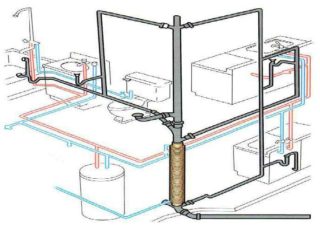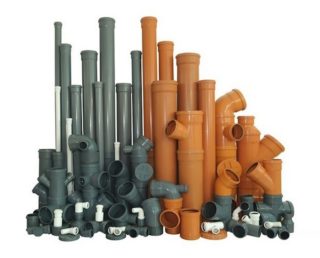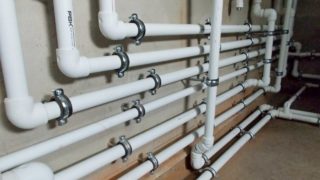Installation of water supply and sewerage systems includes an extensive scope of work. But this does not scare homeowners, since living can be full and comfortable only if there are engineering networks. It is recommended to start work with the design and drawing up a diagram, this will make the work faster, as well as calculate the investments in advance.
Requirements for the laying of water supply and sewerage pipes

For external water supply and sewerage, pipes of high strength and larger diameter are required, since operating conditions will not always be easy, for example, a variable temperature regime, high soil pressure in trenches. The installation of a water supply and sewerage network is carried out at the same time, which reduces the time spent and capital investments. When ordering a project of external communications from specialists, the cost for each meter will depend on many factors, they are negotiated individually when submitting an application.
When laying communication networks on your own, it is important to observe the following requirements:
- Observe the required slope of the pipeline, which will allow the liquid to reach its destination without hindrance. Also, the accuracy and reliability of work depends on the observance of the slope.
- It is recommended to start installation from the exhaust manifold of the internal pipeline network in the house.
- If plastic pipes are used during installation, great efforts must not be applied during installation, as this threatens to damage them.
When self-installing water supply and sewerage systems, they preliminarily draw up diagrams and drawings in accordance with GOST in accordance with all the requirements of SNiP. A permit for the work must be issued by the relevant authorities.
Used tools and materials

Materials for conducting water supply and sewerage systems are different. When choosing a specific one, you need to rely on criteria such as scope, technical parameters, cost, reliability and safety.
The basis of communication systems is pipes. They are made from metal, metal-plastic and plastic:
- Metal pipes are rarely used, since they do not meet modern requirements for reliability and durability. The main disadvantages of the material include instability to corrosion, as well as a negative effect on the taste and color of tap water.
- Pipes made of metal-plastic are reinforced with thin-layer metal, which is enclosed between plastic. They have many advantages, such as long service life, non-corrosive, non-chemical reaction with water, flexible and durable. Assembly does not require the use of special equipment, just fittings. But the cost of such pipes in comparison with metal and plastic pipes is much higher.
- Plastic pipes are made from various polymers. The most popular is polypropylene. For the cold water supply network, ordinary pipes are mounted, and for hot water - special stabilized ones, additionally equipped with a foil layer. The advantages of polypropylene pipes include low cost, durability, lack of reaction with water and resistance to corrosion.The disadvantages are that during installation you cannot do without a special welding machine.
In addition to pipes for communications, you will need to purchase fittings for assembling the system, for example, couplings and transition couplings, ordinary tees and equipped with an internal / external thread, angles and crosses.
Preparatory work
When purchasing a new apartment or house, the owner has several primary tasks - to mount water supply and sewerage communications, as well as to make repairs. As a rule, new buildings are equipped with only a heating system.
Before proceeding with the installation of water supply and sewerage, you need to schematically depict the piping in accordance with the location of the plumbing. It is necessary to determine in advance where the bathroom, sink, toilet and household appliances (washing machine, dishwasher) will be located. The project can be developed independently, but it is better to turn to a professional who, in accordance with the requirements of SNiP, in accordance with all GOSTs, will create drawings.
After obtaining permission to perform work, they begin to select and purchase building materials.
Installation steps

The installation of water supply and sewerage systems inside the building is not difficult if all the instructions are strictly followed. The installation steps are as follows:
- Execute the project and approve it in the relevant authorities. For clarity, it is recommended to depict the passage of pipes directly on the walls of the room. Here, do not forget about the fitting connections. The distance measured with a tape measure is recorded on paper.
- List the required types of fittings that will be used in the installation of water supply and drainage systems. Adapters, angles, couplings and tees are shown on the sheet, their number is counted.
- Decide on the pipes. Most often, polymer materials are used to carry out communications inside the house.
- After purchasing all the necessary materials and tools, you can proceed directly to the installation. Each material requires a special approach to itself, therefore, before installing, you need to familiarize yourself with all the subtleties and nuances. Difficulties should not arise, since the assembly of communications does not require special skills.
- The final stage is the launch of water into the system, checking the tightness of the connections. The pipelines are in normal operation for at least two weeks, during this period all errors will be identified.
It is recommended to additionally equip pipes intended for cold water with a heat insulator, otherwise condensation will form on the surface. It is also worth considering: the fewer connection points, the higher the reliability of the network. You should not lay pipes in zigzags and abuse connecting elements.
The installation of a water supply and sewerage network, as a rule, takes a little time. If the work is carried out by specialists, it will be possible to carry out them within a few hours. When doing the work on your own, it is better to ask for help from a friend, since it will be inconvenient and difficult for one to do everything.
If the installation of water supply and sewerage is carried out in an apartment of an apartment building, you must first take care of disconnecting from the central highway. Also, it will not be superfluous to call the management company in advance so that their plumber provides the key to the basement in case of unforeseen circumstances.








